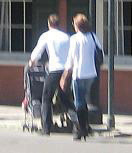Now that you’ve thought about what topics interest you and identified a topic that is both empirical and sociological, you need to form a research questionA way of framing a scientist’s particular problem of interest. about that topic.For many researchers, forming hypotheses comes after developing one’s research question. We’ll discuss hypotheses in Chapter 5 "Research Design". Here our focus is just on identifying a topic and a question. So what makes a good research question? First, it is generally written in the form of a question. To say that your research question is “child-free adults” or “students’ knowledge about current events” or “movies” would not be correct. You need to frame a question about the topic that you wish to study. A good research question is also one that is well focused. Writing a well-focused question isn’t really all that different from what the paparazzi do regularly. As a sociologist you need to be as clear and focused as those photographers who stalk Britney Spears to get that perfect shot of her while she waits in line at Starbucks. OK, maybe what we do as sociologists isn’t exactly the same, but think about how the paparazzi get paid. They must take clear, focused photographs in order to get paid for what they do. Likewise, we will not hit the sociological jackpot of having our research published, read, or respected by our peers if we are not clear and focused. I’ll say a little more about this after we consider three more features of good research questions.
In addition to being written in the form of a question and being well focused, a good research question is one that cannot be answered with a simple yes or no. For example, if your interest is in gender norms, you could ask, “Does gender affect a person’s shaving habits?” but you will have nothing left to say once you discover your yes or no answer. Instead, why not ask, “How or to what extent does gender affect a person’s feelings about body hair?” By tweaking your question in this small way, you suddenly have a much more fascinating question and more to say as you attempt to answer it.
A good research question should also have more than one plausible answer. The student who studied the relationship between gender and body hair preferences had a specific interest in the impact of gender, but she also knew that preferences might vary on other dimensions. For example, she knew from her own experience that her more politically conservative friends were more likely to shave every day and more likely to only date other regular shavers. Thinking through the possible relationships between gender, politics, and shaving led that student to realize that there were many plausible answers to her questions about how gender affects a person’s feelings about body hair. Because gender doesn’t exist in a vacuum she, wisely, felt that she needed to take into account other characteristics that work together with gender to shape people’s behaviors, likes, and dislikes. By doing this, the student took into account the third feature of a good research question: She considered relationships between several concepts. While she began with an interest in a single concept—body hair—by asking herself what other concepts (such as gender or political orientation) might be related to her original interest, she was able to form a question that considered the relationships among those concepts.
In sum, a good research question generally has the following features:
As noted earlier, there are some similarities between the goals of sociologists and those of the paparazzi. A few years ago, shortly before leaving on a trip to New Orleans, I received one of those letters that most of us professional sociologists both dread and receive on a pretty regular basis: a rejection letter. The letter informed me that the paper I had recently submitted, while timely and well written, was being rejected. Apparently the paper lacked focus. In particular, the research question around which the paper was organized was not well focused. As I began to think about how to better focus my research question, and why such focus was so important in the first place, I licked my wounds and boarded a plane to join couple of friends in the Big Easy.
When our taxi pulled up to our lodging in the French Quarter, we noticed the street was lined with cars—and with people who appeared to be living in those cars. On closer examination, we also noticed that most of the car dwellers had cameras, all with very long, wide lenses. Our taxi driver explained that they were paparazzi who were there because Brad Pitt and Angelina Jolie were in town—and that their house was right next to the building where we’d be staying. As the titleholder to the world’s longest crush on Brad Pitt, I was, needless to say, giddy.If you’ve found yourself asking what any of this has to do with research methods, fear not, we’re getting there. But presumably there are others of you out there who, like me, won’t complain about a brief diversion so long as it involves Brad Pitt.
One of my friends was giddy too—but not for the same reason as me. She decided that she would try to pay for her trip by taking the perfect photograph of Brad and Angelina and selling it to the highest bidder. She reasoned that the paparazzi had chosen our street because it must be the best location to photograph the superstars and their kids. In fact, we did see Brangelina a few times. Now I respect every person’s right to privacy, be they my long-standing crush or anyone else. Thus each time we saw Brangelina and kids, I’d jump in front of the camera while my friend tried to snap the perfect shot. As a result, instead of focusing in on Brad and Angelina, her camera always focused on my head. Needless to say, my friend never got a shot worthy of selling to pay for her trip. She did, however, get several of shots of my gigantic melon (my mother didn’t call me pumpkin head for nothing), with Brad, Angelina, and the kids usually blurred in the background. Figure 4.6 "Blocking the Shot" shows one such shot; Figure 4.7 "The Least-Blurry Photo My Friend Was Able to Get" shows the least-blurry photo she was able to get thanks to my sabotage.
Figure 4.6 Blocking the Shot

Figure 4.7 The Least-Blurry Photo My Friend Was Able to Get

So why am I sharing this story and these terribly unflattering photos? The point is that as a sociological researcher, your job is like that of the paparazzi. Just as the paparazzi don’t get paid unless they point their camera in the right direction and focus in on their subjects in exactly the right way, you will not hit the sociological jackpot unless you aim your sociological lens in the right direction and clearly focus your research question. You could be the most eloquent writer in your class, or even in the world, but if the research question about which you are writing is unclear, your work will ultimately fall flat. As I learned right before my trip to New Orleans, a poorly focused research question trumps all. The good news is that much of this text is dedicated to learning how to write, and then answer, a good research question. We’ve done this throughout the text and will continue to do so by considering specific research questions that sociologists have successfully asked and answered in the past. We’ll also do some brainstorming about questions that are of interest to you and consider ways of framing different questions about the same topic by exploring the variety of methodologies that sociologists use to answer their research questions.
Throughout this chapter, you have seen a number of examples of research questions, and you’ve read about features that distinguish good sociological research questions from not-so-good questions. Putting all this advice together, let’s take a look at a few more examples of possible sociological research questions and consider the relative strengths and weaknesses of each. Table 4.2 "Sample Sociological Research Questions: Strengths and Weaknesses" does just that. While reading the table, keep in mind that I have only noted what I view to be the most relevant strengths and weaknesses of each question. Certainly each question may have additional strengths and weaknesses not noted in the table. Also, it may interest you to know that the questions in Table 4.2 "Sample Sociological Research Questions: Strengths and Weaknesses" all come from undergraduate sociology student projects that I have either advised in the course of teaching sociological research methods or have become familiar with from sitting on undergraduate thesis committees. The work by thesis students is cited.
Table 4.2 Sample Sociological Research Questions: Strengths and Weaknesses
| Sample question | Question’s strengths | Question’s weaknesses | Proposed alternative |
|---|---|---|---|
| Do children’s books teach us about gender norms in our society? | Written as a question | Written as a yes/no | What (or how) do children’s books teach us about gender norms in our society? |
| Focused | |||
| Why are some men such jerks? | Written as a question | Lacks theoretical grounding | Who supports sexist attitudes and why? |
| Focused | Biased | ||
| Does sexual maturity change depending on where you’re from? | Written as a question | Unclear phrasing | How does knowledge about sex vary across different geographical regions? |
| Written as a yes/no | |||
| What is sex? | Written as a question | Too broadly focused | How do students’ definitions of sex change as they age? |
| Not clear whether question is sociological | |||
| Does not consider relationships among concepts | |||
| Do social settings and peers and where you live influence a college student’s exercise and eating habits? | Written as a question | Lacks clarity | How does social setting influence a person’s engagement in healthy behaviors? |
| Considers relationships among multiple concepts | Unfocused | ||
| Written as a yes/no | |||
| What causes people to ignore someone in need of assistance? | Written as a question | ||
| Socially relevant | |||
| How do older workers cope with unemployment? (Steenburgh, 2010)Steenburgh, E. (2010). Strategies of older workers reentering the workforce. Honors college thesis, University of Maine, Orono, ME. | Written as a question | ||
| Focused | |||
| More than one plausible answer | |||
| Why do so few college-aged men volunteer? (Bernstein, 2010)Bernstein, J. D. (2010). “Well, he just lost man points in my book”: The absence of first-year college male volunteerism. Honors college thesis, University of Maine, Orono, ME. | Written as a question | ||
| Socially relevant | |||
| More than one plausible answer | |||
| How have representations of race and gender in horror films changed over time? (Potvin, 2007)Potvin, S. (2007). Representations of race and gender in 1970s horror films and their contemporary remakes. Honors college thesis, University of Maine, Orono, ME. | Written as a question | ||
| Considers relationships among multiple concepts |